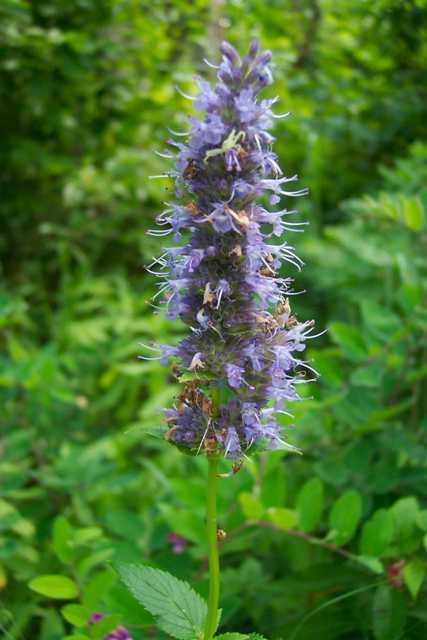Anise Hyssop, Licorice Mint
 |
DescriptionAnise hyssop (Agastache foeniculum (Pursh) Ktze., Lamiaceae) is an erect, branched perennial herb with opposite, toothed leaves and square stems. It is a member of the mint family, and has a pleasant anise-like aroma. The leaves are ovate-triangular, green above and with soft grey hairs below. Flowers are purple-blue, two-lipped, in a dense terminal spike 4 - 8 cm long. It blooms from June to September. It grows up to 1 m tall. History And UsesAnise hyssop has been used by North American First Nations people as a breath-freshener, as a tea and as a sweetener. An infusion of the herb was used for chest pains, and the roots were used for coughs. Agastache is used in Chinese prescriptions for heatstroke, headache, fever, and angina. Leaves are used as poultices for sores. It is used in dried flower arrangement, and the essential oils are used in perfumes and aromatherapy. It is also a good source of nectar. |
Area Of Adaptation
Anise hyssop is found mostly in moist, open woods, along streams and lakeshores, and in wet ditches and prairies. It prefers sandy, moist, well-drained loam, in full sun or very light shade. The pH should be 6 - 6.5. It requires lots of moisture, and wilts if it is too hot. Its natural distribution is from BC across the prairies (in MB north to the Porcupine Mountains) and into western Ontario and the adjacent states. It has been introduced into northeastern North America.
Cultivation And Processing
Propagation is by seed, which germinates easily, by cuttings, or by root divisions. Seedlings and mature plants transplant easily. Use a complete mineral fertilizer or composted manure before planting in the field. Side-dressing with nitrogen 4 - 5 weeks after seeding will increase yields.
Keep well weeded until about 15 cm (6 in.) tall. Anise hyssop is susceptible to beetle and bug attacks. Seed shattering may cause it to become a weed problem in future crops. It should be harvested at the start of flowering, 45 - 60 days after seeding. Use a sickle blade mower and leave a 6 - 8 in. stubble. This will usually allow for a second cutting after it becomes established in its first year. Yields of 200 - 400 lbs/1000 ft2 (9,000 - 18,000 lbs/acre or 10,000 - 20,000 kg/ha) fresh weight are expected. The essential oil can be obtained by steam distillation, preferably from plants at the bud formation growth stage, but composition varies dramatically with plant variety.
Marketing
There is a strong demand in the dried flower trade for anise hyssop, and some demand in the herb tea market. Marketing is generally handled by a broker who will deal with quantities typically produced from half an acre. Methyl chavicol, one of the main constituents of the essential oil in some varieties, is in demand for many industries and could be obtained by fractional distillation.
